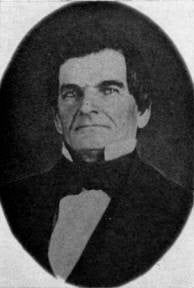History of Morrison, MO
The oldest building in the town is the Shobe-Morrison House. In 1818, a site was acquired by Robert Shobe to build a house, a cow shed to the rear of the site was the first building completed. The original section was built between about 1828 and 1830, with an addition made about 1840. The log I-house, a large, two-story dog-trot style with weatherboard exterior is bound on its two sides by chimneys with fireplaces and has a traditional floor plan. There are two rooms on each floor, joined at the center by a hallway that runs from the front of the house to the back. The interior of the house and Federal style woodwork is remarkably intact as built. The wood has been identified as pine, walnut and chestnut. It was slave built. Mr. Shobe, who was the first man to own land in the Morrison area, was buried in a cemetery on the hill directly south of the house. The house was later owned by the Parsons family. In 1858, land was deeded to John Parker who in turn deeded a tract to Alfred Morrison. In 1860, Morrison acquired another tract of land, which probably included the house.

The town was named for Mr. Alfred William Morrison, who served as the State Treasurer of Missouri from 1851-1861. It is not known if he lived in the house, but the 1860 census shows that his son William J. Morrison was in residence and in March 1860 was appointed Morrison’s first postmaster.
In 1855, the Pacific Railroad began service through Morrison. It has always played an important part in the history of the town. A stockyard was built along the tracks near the depot so farmers could ship their livestock to eastern markets by rail. Railroad workers, passengers and cargo all helped to improve the economy of the town.
The list of businesses in 1879, included: meat market, 2 general stores, wagon maker, 2 saloons, a hotel, a physician, tailor, shoemaker, blacksmith, photographer and a lumber manufacturer. The population at that time was 150 persons.
The estate was sold in 1864, to Julius Meyer, a native of Prussia. Mr. Meyer and his heirs owned the property until 1959, when it was divided and sold. Mr. Meyer was generous to Morrison townspeople. His family gave the land for the present city park along Hwy 100.
The Shobe-Morrison House was deeded to the Morrison Lions Club in 1975, and a federal Bicentennial fund grant was received to renovate the house. It has been placed on the National Register of Historic Buildings in the State of Missouri.
Since the town is on the banks of Bailey’s Creek, a tributary that runs into the Missouri River over a mile away, the threat of floods is always present. A levee was built in the 1950s to protect the town from rising flood waters, but in 1993, flash flood waters topped the levee and the entire lower section of the town, which included most of the businesses, was flooded.

Alfred William Morrison
Missouri 7th State Treasurer: 1851-1861
Alfred William Morrison (Democrat), the 7th State Treasurer, was born November 25, 1802, in Jessamine County, Ky. He moved to Howard County, Mo., in 1820.
He was tutored as a surveyor by his stepfather, and was elected surveyor of Howard County, serving for 10 years, during which time he surveyed the sites of New Franklin, Fayette, Roanoke and Boonesboro. At various times he also served in Howard County as sheriff, assessor and county judge. President Polk appointed him receiver of the land office at Fayette from 1845-1849.
Governor A. A. King appointed him state treasurer in 1851 to fill out the unexpired term of Peter G. Glover, who died in office. Mr. Morrison was re-elected for three terms. The treasurer's salary was raised during his administration to $1,750 per year with a $250,000 bond required. In 1855, the legislature approved an appropriation of $800 per year for clerks' salaries.
In 1858, land in Morrison was deeded to John Parker who in turn deeded a tract to Alfred Morrison. In 1860, Morrison acquired another tract of land, which probably included the house.
The town was named for Mr. Alfred William Morrison, who served as the State Treasurer of Missouri from 1851-1861. It is not known if he lived in the house, but the 1860 census shows that his son William J. Morrison was in residence and in March 1860 was appointed Morrison’s first postmaster.
Mr. Morrison resigned the office in August 1860, rather than take the "test oath" of loyalty the State Convention had provided should be taken by all public officials in Missouri. This oath stated, "each civil officer in this state...take and prescribe an oath...that he will not take up arms against the government of the United States nor the Provisional Government of this state, nor give aid or comfort to the enemies of either during the present Civil War." Upon resigning office, he returned to his Howard County farm, where he spent the rest of his days.
He had two children by his first wife, Minerva Jackson, who died in 1858. He remarried in 1860 to Martha Johnson. Mr. Morrison died on his farm near Fayette on Aug. 24, 1883.

Reach Out to Us Today!
Thank you for your continued support and involvement in making Morrison the home we know and hold dear to our hearts. If you have any questions regarding upcoming community outreach events, would like to report a lost or found animal, or any other concerns, please feel free to call our office. We will get back to you as soon as possible.



